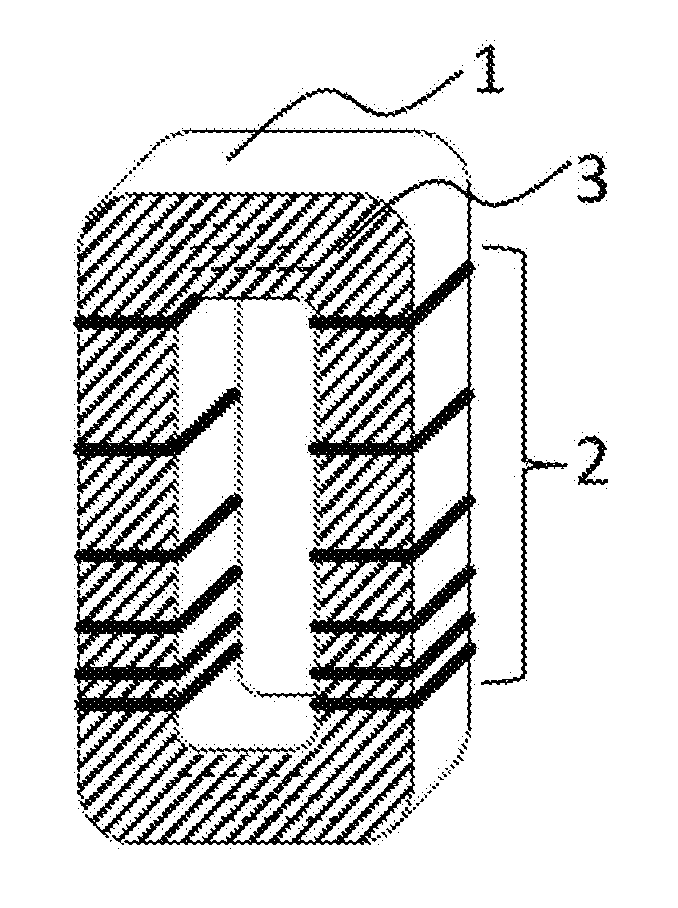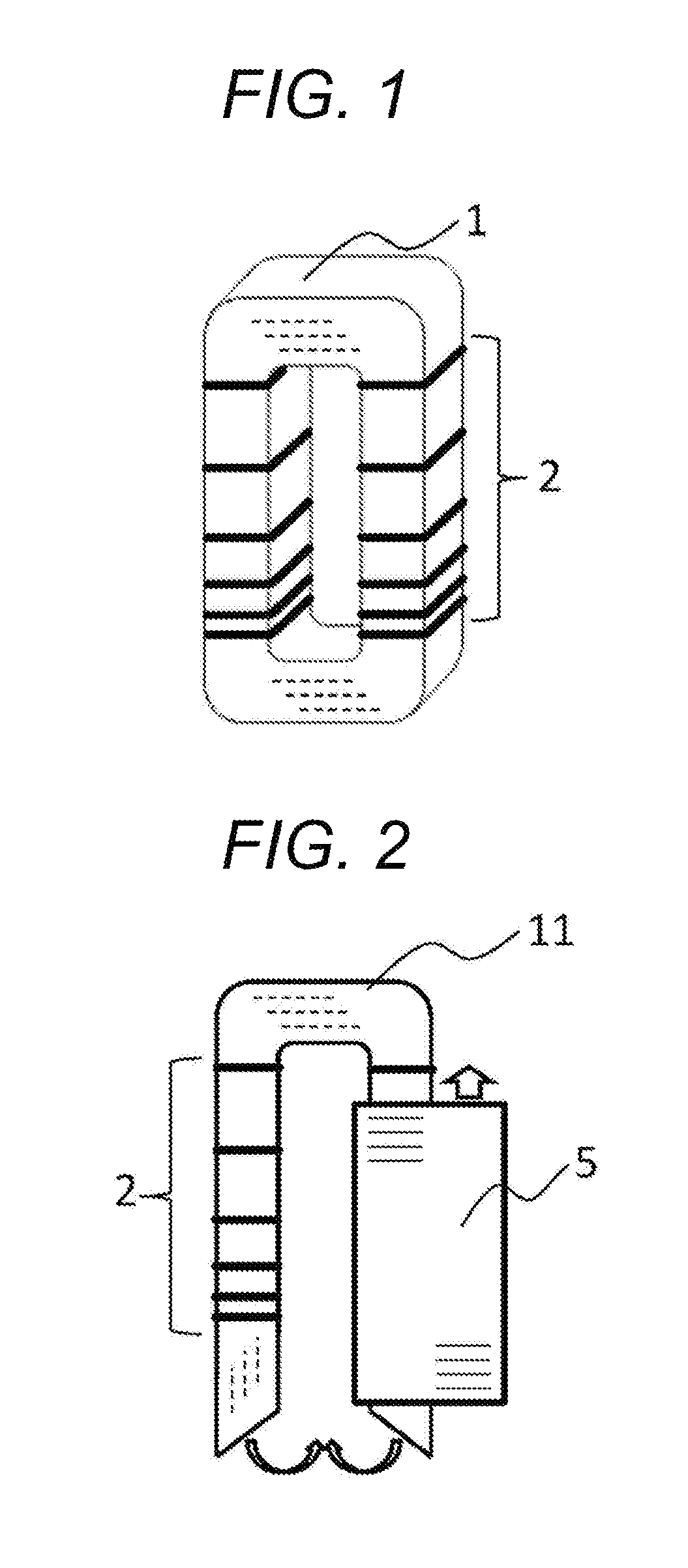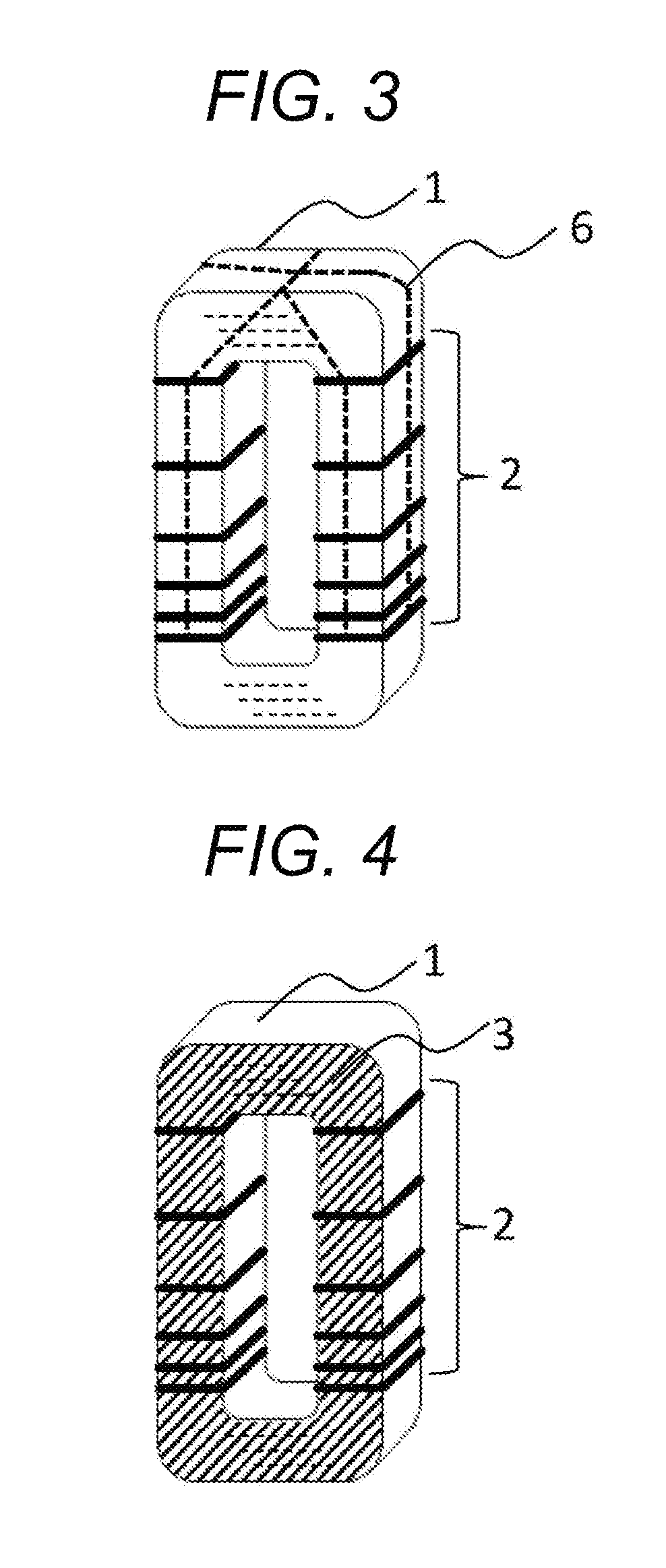Wound core for stationary induction apparatus
a stationary induction and wound core technology, applied in the direction of electrical apparatus, magnetic core, basic electric elements, etc., can solve the problems of increasing the manufacturing cost of transformers, difficult to provide a larger core by the prior art, and the loss of shape of amorphous cores configured with laminated ribbons, so as to achieve the effect of improving the shape-retainability of large wound cores
- Summary
- Abstract
- Description
- Claims
- Application Information
AI Technical Summary
Benefits of technology
Problems solved by technology
Method used
Image
Examples
first embodiment
[0020]The configuration of a core of a transformer will be described referring to FIG. 1. FIG. 1 is a schematic view of a core according to the embodiment. The amorphous wound core 1 is provided in an upright manner. A plurality of uniting binders 2 is provided on a leg to magnetize more sparsely toward the upper portion of the leg to magnetize. The uniting binder 2 is preferably made of a nonmagnetic material, for example, polypropylene. Alternatively, the uniting binder 2 may be made of a magnetic material having a property close to the property of the material of the core, such as a steel band.
[0021]The process of configuring a transformer will schematically be described referring to FIG. 2. First, ribbons each having a single turn are laminated to constitute a laminated core 11 that is opened at one of yokes. The layers of ribbons are bound by uniting binders 2 without applying excessive pressure on the leg to magnetize. A separately prepared coil 5 is attached to the core. The ...
second embodiment
[0026]FIG. 4 is a schematic view of another embodiment core of a transformer. Similarly to the core illustrated in FIG. 1, an amorphous wound core 1 is provided in an upright manner, and uniting binders 2 are provided on a leg to magnetize more sparsely toward the upper portion of the leg to magnetize.
[0027]The difference from the configuration illustrated in FIG. 1 is that the edge face of layers of the core is coated with a resin over the uniting binders. In FIG. 4, the face to which the resin is applied is illustrated with hatching.
[0028]As the coating resin, for example, an epoxy resin which stiffens at normal temperature, a thermoset epoxy resin, or a silicone rubber based resin can be used.
[0029]Configured in such a manner, shifting of the uniting binders caused by vibration during an operation, flaking of ribbon debris from the edge face of layers, and shear displacement between laminated ribbons can be prevented, thereby further improving the shape-retainability of the leg t...
third embodiment
[0031]FIG. 5 is a schematic view of a process of assembling a core of a transformer and a coil. FIG. 6 is a schematic view of the core of a transformer and the coil which are assembled. Similarly to the cores of the first embodiment and the second embodiment, the amorphous wound core 1 is provided in an upright manner, and the uniting binders are provided on the leg to magnetize more sparsely toward the upper portion of the leg to magnetize.
[0032]To facilitate the understanding of the whole configuration, only one of the coils 5 is illustrated in the drawing, omitting the other coil, so that the configuration of the core and the uniting binders can be understood. A resin is applied to the portion illustrated with hatching.
[0033]The assembling procedure of attaching the coil 5 to the core 11, which is an amorphous wound core having an opened end and a turn, and connecting the opened end is conducted as follows. The uniting binders 2 are provided on the leg to magnetize, and then a co...
PUM
| Property | Measurement | Unit |
|---|---|---|
| thickness | aaaaa | aaaaa |
| circumference | aaaaa | aaaaa |
| magnetic property | aaaaa | aaaaa |
Abstract
Description
Claims
Application Information
 Login to View More
Login to View More - R&D
- Intellectual Property
- Life Sciences
- Materials
- Tech Scout
- Unparalleled Data Quality
- Higher Quality Content
- 60% Fewer Hallucinations
Browse by: Latest US Patents, China's latest patents, Technical Efficacy Thesaurus, Application Domain, Technology Topic, Popular Technical Reports.
© 2025 PatSnap. All rights reserved.Legal|Privacy policy|Modern Slavery Act Transparency Statement|Sitemap|About US| Contact US: help@patsnap.com



